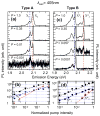Highly emissive multiexcitons in steady-state photoluminescence of individual "giant" CdSe/CdS Core/Shell nanocrystals
- PMID: 20515013
- PMCID: PMC2912411
- DOI: 10.1021/nl1004652
Highly emissive multiexcitons in steady-state photoluminescence of individual "giant" CdSe/CdS Core/Shell nanocrystals
Abstract
The development of nanocrystal quantum dots (NQDs) with suppressed nonradiative Auger recombination has been an important goal in colloidal nanostructure research motivated by the needs of prospective applications in lasing devices, light-emitting diodes, and photovoltaic cells. Here, we conduct single-nanocrystal spectroscopic studies of recently developed core-shell NQDs (so-called "giant" NQDs) that comprise a small CdSe core surrounded by a 16-monolayer-thick CdS shell. Using both continuous-wave and pulsed excitation, we observe strong emission features due both to neutral and charged biexcitons, as well as multiexcitons of higher order. The development of pronounced multiexcitonic peaks in steady-state photoluminescence of individual nanocrystals, as well as continuous growth of the emission intensity in the range of high pump levels, point toward a significant suppression of nonradiative Auger decay that normally renders multiexcitons nonemissive. The unusually high multiexciton emission efficiencies in these systems open interesting opportunities for studies of multiexciton phenomena using well-established methods of single-dot spectroscopy, as well as new exciting prospects for applications, that have previously been hampered by nonradiative Auger decay.
Figures





References
-
- Klimov VI. Ann Rev Phys Chem. 2007;58:635–673. - PubMed
-
- Klimov VI, McGuire JA, Schaller RD, Rupasov VI. Phys Rev B. 2008;77(19)
-
- Efros AL, Kharchenko VA, Rosen M. Solid State Commun. 1995;93(4):281–284.
-
- Klimov VI, Mikhailovsky AA, Xu S, Malko A, Hollingsworth JA, Leatherdale CA, Eisler HJ, Bawendi MG. Science. 2000;290(5490):314–317. - PubMed
-
- Klimov VI, Ivanov SA, Nanda J, Achermann M, Bezel I, McGuire JA, Piryatinski A. Nature. 2007;447(7143):441–446. - PubMed
Publication types
Grants and funding
LinkOut - more resources
Full Text Sources

